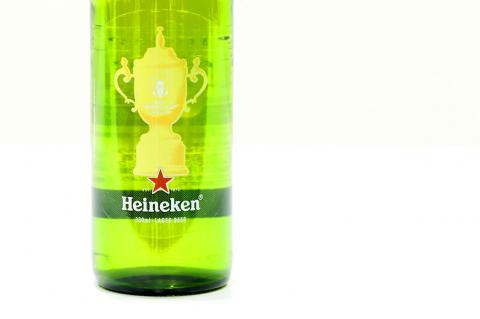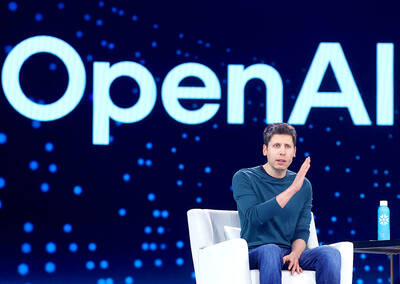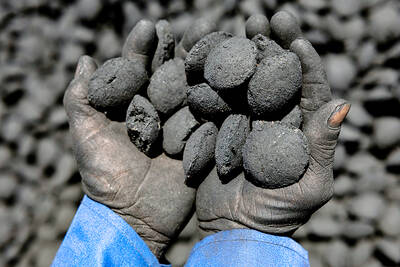Beer vendors are a common sight at Japanese baseball games as they hurry up and down the terraces with sloshing containers strapped to their backs, and rugby union fans will also be able to enjoy a taste of the country’s unique sports viewing culture in September when the uriko are unleashed at the Rugby World Cup.
Uriko have been a feature at Japanese sporting events for decades, but are synonymous with baseball, the country’s most popular sport.
Under the concourse of Meiji Jingu Stadium, nestled in the shadow of the under-construction Olympic Stadium and home to the Tokyo Yakult Swallows baseball team, 160 beer vendors, all female bar one, are getting ready for a busy shift.

Photo: Bloomberg
Among them is 20-year-old Ririko Saito, who makes her final preparations as the first groups of supporters file into the stadium.
Saito shares a laugh with her colleagues as she applies the finishing touches to her make-up and gulps down cold tea, crucial hydration on a late afternoon when temperatures reach almost 30°C.
CAMARADERIE
There is camaraderie, but also tension. Earnings are based on commission, so competition between vendors is fierce, with speed and efficiency the order of the day.
On a good day, the top vendors will expect to sell more than 200 cups of beer during the game, with beers going for ¥750 (US$6.96) a cup.
Top performing vendors such as Saito have regulars, usually season-ticket holders, they can quickly pick out in the crowd, but when looking to attract new customers, little details can make all the difference.
Saito wears earrings in the shape of foaming glasses of beer, while another vendor sports a badge indicating that she speaks English.
ACTION
Uriko might portray an image of calm and control when gliding swiftly through the baseball-watching crowd, but beneath the terraces there is a whirlwind of action.
In the refilling station, likened by one of the vendor organizers to a Formula One pit-lane, workers aim to refill each vendor’s beer backpack and send them out into the crowd as soon as possible. The record is 13 seconds.
The stadium’s operations manager said the whole beer delivery apparatus, including mini-keg, gas canister and sprayer, weighed as much as 17kg.
“It is very hard, so hard that I usually get sore muscles the day after and sometimes I cannot stand up,” Saito says. “I have that especially at the beginning of the season, but I am getting used to this.”
The uriko are well-loved in Japan and many young fans grow up wanting to be one.
“Since I was small, my family liked baseball and we often went to baseball at a stadium,” said 19-year-old Ami Maeda, who has been working at Meiji Jingu for two years. “When my parents bought beer, the smiles of the uriko were very pretty so I knew I wanted to be a uriko when I grew up.”
MOVIE STARS?
With the bulky, beer-filled bag on their backs and armed with a quick-action beer spray, the uriko resemble the lead characters from Ghostbusters as they deliver drinks to fans.
“I couldn’t imagine watching baseball without them,” Swallows fan Hiroshi Takeda said.
Perhaps after their introduction at the World Cup, rugby fans too will be unable to watch their sport without uriko.
Cup organizers have made it a priority to keep the beer flowing during games, with World Rugby officials visiting various host cities to hammer home that message.
They expect foreign fans to drink more than four times as much beer as Japanese fans during games and so have turned to uriko to help meet the demand.
“We have various unique methods of selling beer in this country,” said Hiroki Matusaki, sales director at Heineken-Kirin, the official beer suppliers of the World Cup. “As often seen at baseball and soccer stadiums, we have uriko, which is truly unique in Japan, so organizers are working on this, but I think it would be a good surprise for non-Japanese spectators to see the unique way of selling beer.”
More than 400,000 foreign fans are expected during the Rugby World Cup, which runs from Sept. 20 to Nov. 2.

DIVIDED VIEWS: Although the Fed agreed on holding rates steady, some officials see no rate cuts for this year, while 10 policymakers foresee two or more cuts There are a lot of unknowns about the outlook for the economy and interest rates, but US Federal Reserve Chair Jerome Powell signaled at least one thing seems certain: Higher prices are coming. Fed policymakers voted unanimously to hold interest rates steady at a range of 4.25 percent to 4.50 percent for a fourth straight meeting on Wednesday, as they await clarity on whether tariffs would leave a one-time or more lasting mark on inflation. Powell said it is still unclear how much of the bill would fall on the shoulders of consumers, but he expects to learn more about tariffs

NOT JUSTIFIED: The bank’s governor said there would only be a rate cut if inflation falls below 1.5% and economic conditions deteriorate, which have not been detected The central bank yesterday kept its key interest rates unchanged for a fifth consecutive quarter, aligning with market expectations, while slightly lowering its inflation outlook amid signs of cooling price pressures. The move came after the US Federal Reserve held rates steady overnight, despite pressure from US President Donald Trump to cut borrowing costs. Central bank board members unanimously voted to maintain the discount rate at 2 percent, the secured loan rate at 2.375 percent and the overnight lending rate at 4.25 percent. “We consider the policy decision appropriate, although it suggests tightening leaning after factoring in slackening inflation and stable GDP growth,”

Meta Platforms Inc offered US$100 million bonuses to OpenAI employees in an unsuccessful bid to poach the ChatGPT maker’s talent and strengthen its own generative artificial intelligence (AI) teams, OpenAI CEO Sam Altman has said. Facebook’s parent company — a competitor of OpenAI — also offered “giant” annual salaries exceeding US$100 million to OpenAI staffers, Altman said in an interview on the Uncapped with Jack Altman podcast released on Tuesday. “It is crazy,” Sam Altman told his brother Jack in the interview. “I’m really happy that at least so far none of our best people have decided to take them

As they zigzagged from one machine to another in the searing African sun, the workers were covered in black soot. However, the charcoal they were making is known as “green,” and backers hope it can save impoverished Chad from rampant deforestation. Chad, a vast, landlocked country of 19 million people perched at the crossroads of north and central Africa, is steadily turning to desert. It has lost more than 90 percent of its forest cover since the 1970s, hit by climate change and overexploitation of trees for household uses such as cooking, officials say. “Green charcoal” aims to protect what